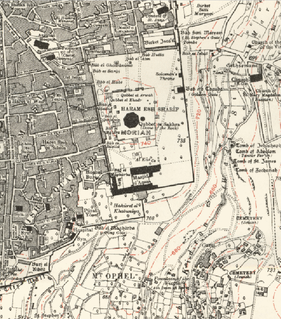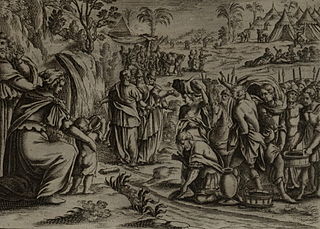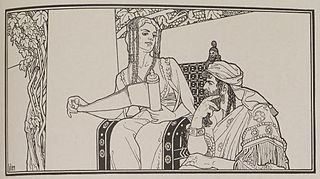Related Research Articles
Aenon, distinguished as Aenon near Salim, is the site mentioned by the Gospel of John as one of the places where John was baptising people, after baptizing Jesus in Bethany-beyond-the-Jordan.
Zaretan or Zarethan, also known as Zeredathah, is a city mentioned in the Hebrew Bible as near the location where the Hebrews crossed the Jordan. In the books of Joshua and 1 Kings, it is called Zarethan, but in 2 Chronicles it is called Zeredathah.
Ramoth-Gilead, was a Levitical city and city of refuge east of the Jordan River in the Hebrew Bible, also called "Ramoth in Gilead" or "Ramoth Galaad" in the Douay–Rheims Bible. It was located in the tribal territorial allotment of the tribe of Gad.

Moriah is the name given to a mountainous region in the Book of Genesis, where the binding of Isaac by Abraham is said to have taken place. Jews identify the region mentioned in Genesis and the specific mountain in which the near-sacrifice is said to have occurred with "Mount Moriah", mentioned in the Book of Chronicles as the place where Solomon's Temple is said to have been built, and both these locations are also identified with the current Temple Mount in Jerusalem. The Samaritan Torah, on the other hand, transliterates the place mentioned for the binding of Isaac as Moreh, a name for the region near modern-day Nablus. It is believed by the Samaritans that the near-sacrifice actually took place on Mount Gerizim, near Nablus in the West Bank.

Easton is a city in and the county seat of Northampton County, Pennsylvania. The city's population was 28,217 as of the 2020 census. Easton is located at the confluence of the Lehigh River, a 109-mile-long (175 km) river, that joins the Delaware River in Easton and serves as the city's western geographic boundary with Phillipsburg, New Jersey.

The Susquehanna River is a major river located in the Mid-Atlantic region of the United States, overlapping between the lower Northeast and the Upland South. At 444 miles (715 km) long, it is the longest river on the East Coast of the United States. By watershed area, it is the 16th-largest river in the United States, and also the longest river in the early 21st-century continental United States without commercial boat traffic.
Calneh (כַלְנֵה) was a city founded by Nimrod, mentioned twice in the Hebrew Bible. The verse in Genesis reads:
Rehoboth is the name of three biblical places:
Tahpanhes or Tehaphnehes; Hebrew: תַּחְפַּנְחֵס, romanized: Taḥpanḥēs or Hebrew: תְּחַפְנְחֵס, romanized: Tǝḥafnǝḥēs; known by the Ancient Greeks as the (Pelusian) Daphnae and Taphnas (Ταφνας) in the Septuagint, now Tell Defenneh) was a city in ancient Egypt. It was located on Lake Manzala on the Tanitic branch of the Nile, about 26 km from Pelusium. The site is now situated on the Suez Canal.

Marah is one of the locations which the Exodus identifies as having been travelled through by the Israelites, during the Exodus.

The Karkheh or Karkhen کرخه is a river in Khūzestān Province, Iran that rises in the Zagros Mountains, and passes west of Shush, eventually falling in ancient times into the Tigris just below its confluence with the Euphrates very near to the Iran-Iraq border. In modern times, after approaching within 16 kilometres (10 mi) of the Dez River, it turns to the southwest and then, northwest of Ahvaz, turns northwest and is absorbed by the Hawizeh Marshes that straddle the Iran–Iraq border. Its peculiarly sweet water was sacred to the use of the Persian kings. Ancient names for the Karkheh should be treated as conjectural because the bed of the river has changed in historic times, and because a nearby watercourse between the Karkheh and the Dez River, the Shaur, confuses the identification.

Lemuel is the name of a biblical king mentioned in Proverbs 31:1 and 4, but whose identity remains uncertain. Speculation exists and proposes that Lemuel might have been king of Massa, while some identified him with Hezekiah or Solomon.

The Pennsylvania Canal was a complex system of transportation infrastructure improvements including canals, dams, locks, tow paths, aqueducts, and viaducts. The Canal and Works were constructed and assembled over several decades beginning in 1824, the year of the first enabling act and budget items. It should be understood the first use of any railway in North America was the year 1826, so the newspapers and the Pennsylvania Assembly of 1824 applied the term then to the proposed rights of way mainly for the canals of the Main Line of Public Works to be built across the southern part of Pennsylvania.

Alcoholic beverages appear in the Hebrew Bible, after Noah planted a vineyard and became inebriated. In the New Testament, Jesus miraculously made copious amounts of wine at the marriage at Cana. Wine is the most common alcoholic beverage mentioned in biblical literature, where it is a source of symbolism, and was an important part of daily life in biblical times. Additionally, the inhabitants of ancient Israel drank beer, and wines made from fruits other than grapes, and references to these appear in scripture.

The Tomb of Daniel is the traditional burial place of the biblical figure Daniel. Various locations have been named for the site, but the tomb in Susa, in Iran, is the most widely accepted site, it being first mentioned by Benjamin of Tudela, who visited Asia between 1160 and 1163.

Daniel is the main character of the Book of Daniel. According to the Hebrew Bible, Daniel was a noble Jewish youth of Jerusalem taken into captivity by Nebuchadnezzar II of Babylon, serving the king and his successors with loyalty and ability until the time of the Persian conqueror Cyrus, all the while remaining true to the God of Israel. The consensus of most modern scholars is that Daniel is not a historical figure and that the book is a cryptic allusion to the reign of the 2nd century BCE Hellenistic king Antiochus IV Epiphanes.

Daniel is usually considered by Muslims in general to have been a prophet and according to Shia Muslim hadith he was a prophet. Although he is not mentioned in the Qur'an, nor in hadith of Sunni Islam, Sunni Muslim reports of him are taken from Isra'iliyyat, which bear his name and which refer to his time spent in the den of the lions. There are debates, however, that go on about Daniel's time of preaching and while in reports of Shia Islam from the Shia Imams he is considered as a prophet, some Muslims from other branches of Islam believe that he was not a prophet but a saintly man. Some Muslim records suggest that a book regarding apocalyptic revelations was found in a coffin, which is supposed to have contained the remains of Daniel, which was brought to light at the time of the Muslim conquest of Tustar, and buried again at the request of Umar.
Tel Abib is an unidentified tell on the Kebar Canal, near Nippur in what is now Iraq. Tel Abib is mentioned by Ezekiel in Ezekiel 3:15:
Then I came to them of the captivity at Tel Abib, that lived by the river Chebar, and to where they lived; and I sat there overwhelmed among them seven days.

Zababa-šuma-iddina was the 35th and next to last king of the Kassite or 3rd dynasty of Babylon, who reigned for just one year, ca. 1158 BC. He was without apparent ties to the royal family and there is uncertainty concerning the circumstances of his coming to power.
References
- 1 2
 Easton, Matthew George (1897). "Ulai". Easton's Bible Dictionary (New and revised ed.). T. Nelson and Sons.
Easton, Matthew George (1897). "Ulai". Easton's Bible Dictionary (New and revised ed.). T. Nelson and Sons. - ↑ Smith, Wiliam, ed. (1863). A dictionary of the Bible. Vol. 3. London. p. 1300.
it appears that the Choaspes (Kerkhah) originally bifurcated at Pai Pul, 20 miles above Susa, the right arm keeping its present course, while the left flowed a little to the east of Sus
- ↑ Driver, Samuel Rolles (1900). The book of Daniel. Cambridge: University Press. p. 112.
the Eulaeus was a large artificial canal some 900 feet broad, of which traces remain, though it is now dry, which left the Choaspes at Pai Pul, about 20 miles N.-W. of Susa, passed close by the town of Susa on the N. or N.-E., and afterwards joined the Coprates